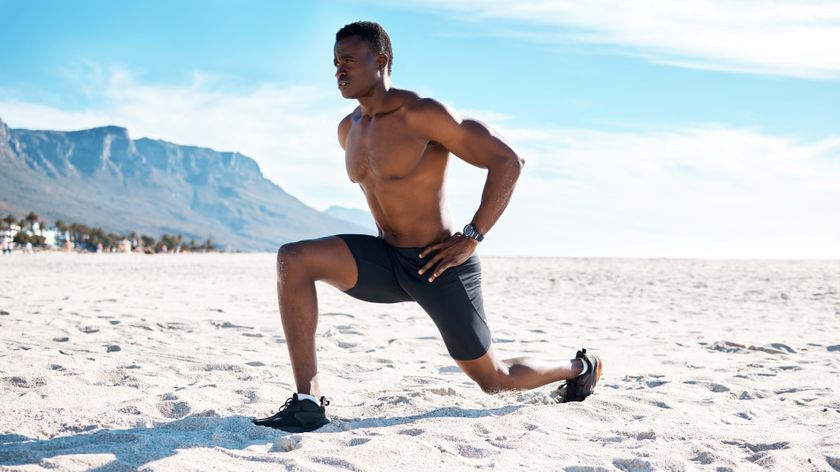
If you suffer from sciatica, exercising could improve your symptoms. But some exercises can worsen pain, so it’s key to know where to draw the line before you hit the ground running.
Your sciatic nerve is the longest in your body, running from your lower back through your hips, rear, and legs, down to your feet. And sciatica is more common than you think. According to the Harvard Medical School, as many as 40% of us will suffer from sciatica, and people with back pain are more susceptible to it. Your risk also increases if you’re older, obese, you’re a smoker, or if you’re sedentary.
If you need some inspiration for lower back stretches, these are the best exercises to strengthen your lower back, and this lower back stretch can help with back pain, but it’s worth noting you should always see a qualified health professional if you’re unsure or new to exercise.
In the meantime, we can say for certain which exercises you should be avoiding — and it’s not surprising. Read on to find out more.
What is sciatica?

Sciatica is pain characterized by tingling, numbness, or pain in your back and legs. According to the Mayo Clinic, sciatica is mostly caused by damage or irritation to the sciatic nerve, like a herniated disc or pinched nerve. Because your sciatic nerve is responsible for motor and sensory functions, it’s crucial for helping you move and feel sensations in your lower body, and pain in the nerve can feel debilitating when standing or walking, let alone working out.
Acute (mild) sciatica can usually be handled without medical intervention and eases over a few weeks with rest, but chronic sciatica can be lifelong. Although some exercises are sadly off the table, gentle exercise is one of the best ways to treat the condition. So it comes down to what helps and what hinders.
Avoid this exercise with sciatica

According to Dr. Serge Nikolic, a consultant in pain medicine specializing in spinal pain management at London Bridge Hospital, rugby is a goner. As a general rule, high-impact sports should be avoided because they can significantly worsen pain and aggravate sciatica. “But the worst of all exercises would be rugby,” he says. “Sprinting coupled with contact and tackling may cause further damage, increasing the pain and duration.”
Sign up to get the BEST of Tom's Guide direct to your inbox.
Get instant access to breaking news, the hottest reviews, great deals and helpful tips.
Sorry, rugby lovers. That also means a no-go for sudden forward bending, jumping, sprinting, or rotation. For example, burpees, Russian twists, tuck jumps, and back-loaded squats are some of the main exercises likely to worsen your pain, alongside HIIT classes and core exercises where your back is unsupported — like toe touches or hanging leg raises.
But just because it’s no longer unadvisable to take your mate out by the legs, a study published in Spine says, “for people with acute low back pain, advice to rest in bed is less effective than that to stay active.” You’ll just need to be a bit more gentle with your approach.
Exercises for sciatica

Traditionally, doctors' orders were bed rest to treat sciatica, but Dr. Nikolic offers another approach. “In an acute stage of sciatica, rest is best with some painkillers,” he says. “Then I recommend gentle stretches and a rocking movement of the pelvis with the leg bent. The best way forward is a gradual increase in loading.”
Nikolic also says to avoid trying to “push past” pain. “I would suggest slow, gentle exercise like Yin yoga, ideally under supervision,” he advises. “There is some evidence to suggest that prolonged myofascial stretching facilitates healing, but it’s important to remember there isn’t a universal recipe. If an exercise regime aggravates pain, medical advice should be sought.”
The research Nikolic refers to has shown that myofascial release could help chronic pain. It’s a manual therapy technique used in massage that focuses on reducing tightness in “trigger points” within myofascial tissue — the tissue surrounding your muscles. In short, it helps to loosen up movement and reduce sensitivity.
Alongside stretching and mobility exercises, this could improve your range of motion and flexibility, which are restricted when you’re in pain. You can find some of the best foam rollers up to the task, and for more low-impact options, check out our review of the Schwinn 270 recumbent exercise bike if you enjoy cycling, and our favorite walking workouts.
Ways to manage sciatica and avoid it
Ice and heat packs were traditionally used to improve blood flow and ease pain, but they should always be used with caution, especially if you have localized numbness in the area.
According to Chanatry Chiropractic, alternating hot with cold for approximately 20 minutes can relax the piriformis (your deep gluteal muscle) in your rear, reduce pain, and help prevent it from compressing your sciatic nerve. But — again— seek medical advice first.
Massage guns and vibration therapy can also help reduce muscle soreness but shouldn’t be applied directly to an injury, and there are some do’s and don’ts to consider. You can find out when you shouldn’t use a massage gun here, and we’ve also rounded up the best massage guns you can buy to soothe those sore muscles post-workout.
Moreover, incorporating core exercises into your workout regime, exercising regularly, and managing your weight are all preventative measures to avoid sciatica altogether.
Next up: The best mattresses for back pain, the best core exercises for beginners, and the best yoga mats for stretching at home.

Sam Hopes is a level 3 qualified trainer, level 2 reiki practitioner and senior fitness writer at Tom's Guide. She is also currently undertaking her Yoga For Athletes training course. Sam has written for various fitness brands and websites over the years and has experience across brands at Future such as Live Science, Fit&Well, Coach, and T3.
Having worked with fitness studios like F45 and Virgin Active, Sam now primarily teaches outdoor bootcamps, bodyweight, calisthenics and kettlebells. She also coaches mobility and stretching-focused classes several times a week and believes that true strength comes from a holistic approach to training your body.
Sam has completed two mixed doubles Hyrox competitions in London and the Netherlands and finished her first doubles attempt in 1:11.























